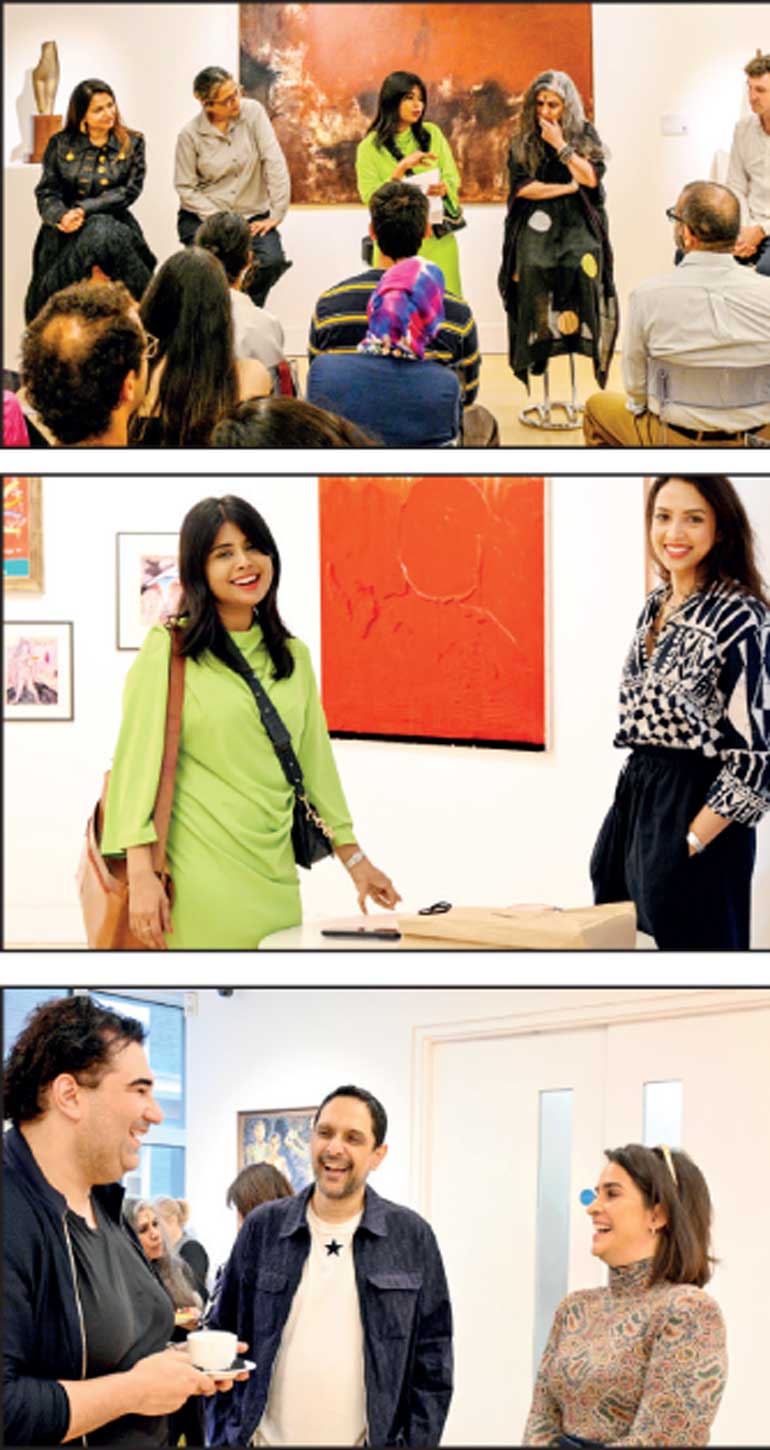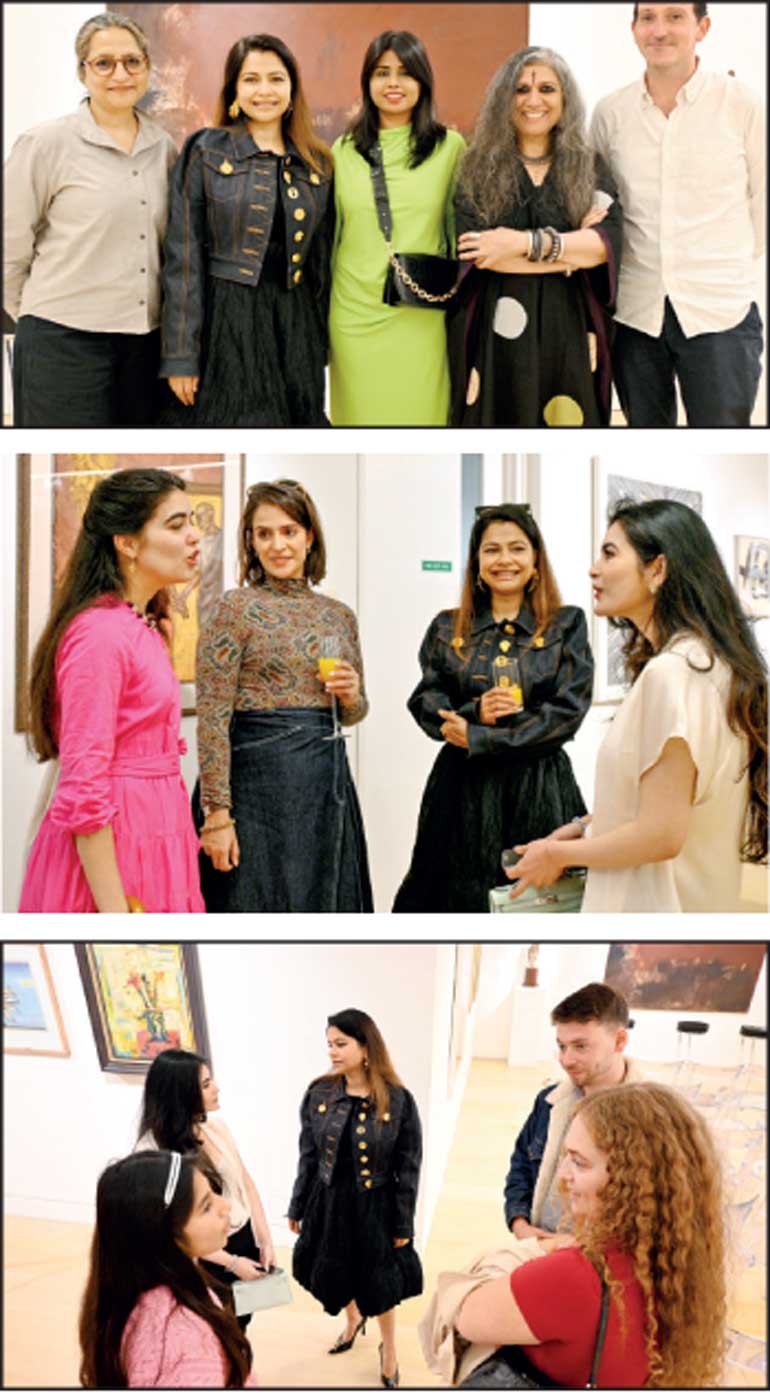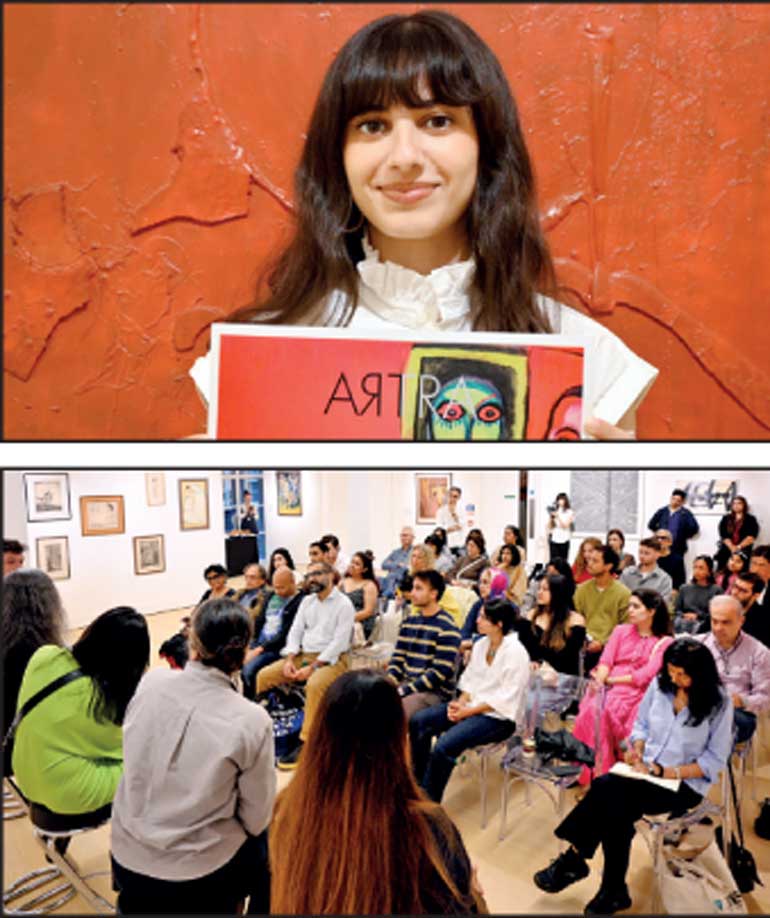Monday Dec 15, 2025
Monday Dec 15, 2025
Saturday, 2 August 2025 00:28 - - {{hitsCtrl.values.hits}}



“What binds together South Asian artists are shared histories, profound civilisations and colonised pasts with similar political, social, and cultural climates,” shared ARTRA Magazine Editor-in-Chief Azara Jaleel as she addressed the audience at Phillips, Berkeley Square, London, last Saturday. She characterised this shared South Asian spirit, remarking, “Defiance was certainly a key characteristic observed to be ever present in the works of these contemporary South Asian artists.” From Pakistani artist Ali Kazim’s use of indigo across his collection ‘Weight of Blue’ (2023) to Bangladeshi artist Tayeba Begum Lipi’s blue-skinned woman titled ‘Gothna as Venus’, these works refer to the coloured form of Lord Krishna, emanating the cosmic power seeped within the ‘coloured’ body, and thus starkly subverts the orientalist reading of it by empowering it with the divine. Referencing the textile work of Anoli Perera, Jaleel outlines how this shared defiance permeates art in the Sri Lankan context, expressing how the artist’s unique response to imperialism through her craft-making, her engagement in textile weaving and needle point art in itself defies British academic traditions during the colonial period.
Moderated by Jaleel, the panel discussion titled ‘South Asian Modern and Contemporary Art in Britain’ explored the potency of the artistic practices and colonial histories across India, Pakistan, Sri Lanka and Bangladesh, while raising questions about the appetite and representation of South Asian art beyond traditional gallery formats. It hosted an esteemed group of panellists from the international art scene. This included Samdani Art Foundation President, Dhaka Art Summit (DAS) Director and Tate’s South Asia Acquisitions Committee and Tate’s International Council member Nadia Samdani MBE among many others, Anita Dawood, an independent editor and editorial consultant, who has commissioned and developed publications for public institutions, publishers and galleries; and worked collaboratively on artists and curator’s books in the UK, Pakistan and Hong Kong. The panel also hosted Rekha Rodwittiya, an artist, independent curator, writer, and teacher having around 40 years of experience in the field of art, and Grosvenor Gallery Director and Co-owner Charles Moore. Before joining the gallery in 2012, he was a specialist at Bonhams Auctioneers in the field of Middle Eastern and South Asian Modern and Contemporary art.
Characterising the forward momentum of South Asian art in the global stage in recent years, Charles Moore stated, “In the last decade things have moved at quite a pace. It’s important to remember that the market as we know it has only really been going for about 25 years now. Around 2000 to 2002 is when we saw a real uptick in the interest in South Asian Modernism.” His words prove astute in light of Grosvenor Gallery’s recent partnership with Phillips on their latest exhibition ‘Crossing Borders: Modern Art from South Asia’ an ambitious showcase of Modern works from the South Asian region.
Though the panel centred around the increasing interest in South Asian art in the global art market, it raised a pertinent question about the overarching system of the art industry: What does it mean for South Asian art to be recognised by a public collection in this day and age? Calling into question the ‘white box’ of a traditional gallery space, Rekha Rodwittiya – herself an established Indian contemporary artist who has showcased in over a hundred national and international exhibitions – posited that South Asian art by its own nature is a community-driven practice. “This idea of putting a market value and deciding that if a museum holds somebody’s work it therefore becomes significant…is that really the manner in which we want to record and articulate how we perceive histories, how we perceive languages and re-scripting – because [India is] a colonised nation, and I’m tired of the pretence of trying to erase it.” She goes on to acknowledge the power and significance of recognised South Asian women Modernists such as Amrita Sher-Gil, Mangalabai Tampuratti and Zubeida Agha. In discussion with Jaleel, she emphasised the importance of bringing the works of women Modernists to the forefront, as their art serves as crucial and empathetic insights into the lived experiences of women from that era. This sentiment echoes the works of Swanee Jayawardene, whose depictions of the female figure veer towards the disturbing and fearsome, invoking viewers to ‘deeply question the veracity, the emotive impulses or the lack of, depicted by her male peers.’ (Jaleel, ARTRA Magazine E69 2025). In doing so, Jayawardene presents a rebellion towards the normative depictions of dignified or sensuous women that populate Sri Lankan Modernism through the work of male artists such as George Keyt and Harry Pieris.
The innate austerity of a gallery space or an art museum can often come across as intimidating to people, and can segregate the consumption of art as a practice left to those who can afford it. Jaleel, in line with Rodwittiya’s questioning of the traditional chains of the art industry, highlighted the pressing need for new alternate spaces for showcasing art. Citing ARTRA’s ongoing initiative to showcase emerging, mid-career and established Sri Lankan artists in inventive fashion, she highlighted ARTRA’s ‘Island Gallery’ which utilises unconventional spaces in Sri Lanka to bring art more accessible to the public. From the most recent collection of exhibitions in a private collector’s home in Colombo, to historic hotels in the Galle Fort such as The Fort Printers, Galle Fort Hotel and The Charleston, and culturally significant spaces such as Brief Garden by Bevis Bawa in Bentota, this initiative brings the exciting narratives of local artists to the forefront, and attempts to refashion the traditional gallery concept, breaking down the barriers to entry to Sri Lanka’s art scene.
Accessibility becomes a critical point of contention in the world of art; though art has been rapidly expanding as an industry, local art scenes tend to suffer from a lack of public awareness and engagement especially in South Asian countries. Nadia Samdani, reflecting upon the beginnings of the Dhaka Art Summit which she founded alongside her husband Rajeeb Samdani, stated that the initiative was founded in order to encourage larger consumption and awareness of Bangladeshi art. The Dhaka Art Summit was conceptualised as an alternative to the traditional gallery system from its inception, amidst the landscape of Bangladesh’s art scene which still does not have a strong gallery system. It became a point of accessibility for the public to experience a world of local contemporary art that seemed shrouded in shadow. Art publications and writings about art practitioners also become an important avenue for accessibility, added Anita Dawood, sourcing her background as a collaborator for art publications. Publications can serve as an alternative medium for people to consume content about art, and at times can be the more accessible option–if not free for consumption online, they may prove the more affordable option.
The art talk ‘South Asian Modern Art in Britain’ is the second iteration of ARTRA’s international art talks in the UK. On 14 May 2024, ARTRA debuted its first international art talk ‘ARTRA Unveiled’ at the Royal Academy of Art in Piccadilly, hosted by Friends of Sri Lanka, UK.
Together with Art Historian and Academic Professor David Robson, Azara Jaleel conversed about ARTRA’s 12-year journey, milestones and the premise of ARTRA Magazine’s Art Legacies Editions. Later that same month, ARTRA held its second talk ‘Sri Lankan Modern Art | Beyond The Shores’ at Grosvenor Gallery in St. James’s where Art Historian Dr. Shamil Wanigaratne and Gallerist Charles Moore together with Azara Jaleel explored the significance of the ‘43 Group in characterising South Asian Art whilst also shedding light on the female artists who were invited to showcase during their exhibitions.